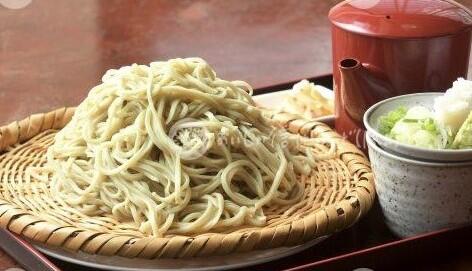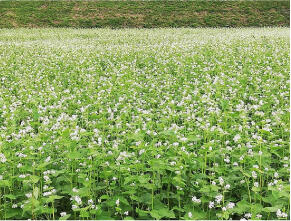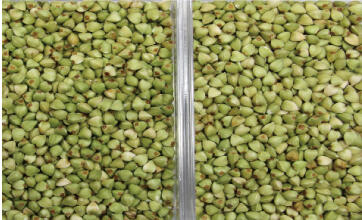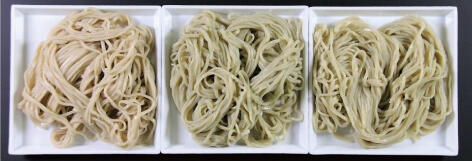(This is an English translation of the original Japanese article.
The publication date refers to that of the Japanese version,
which differs from the upload date of the English version.)
In Nagano Prefecture's soba noodle shops, you may come across "Shinshu Hisui Soba," a type of soba noodle that has a Jade-like greenish color. This Shinshu Hisui Soba is made from a variety of buckwheat that was developed by Nagano Prefecture. Due to its low production volume, there is a demand for increased production. Therefore, Nagano Prefecture has advanced the improvement of the variety and developed a variety that can be harvested by machine and cultivated by producers without extra burden.
Named after the image of jade
Nagano Prefecture is the second largest producer of soba after Hokkaido, and recently, shops with "Hisui Soba" signs have become more noticeable.
"Hisui" refers to the gemstone "jade" in Japanese, which shines in a translucent green color. The noodles have a color similar to jade. Painter and essayist, Toyoo Tamamura, proposed the name, "Shinshu Hisui Soba." This was then recognized as a registered trademark of Nagano Prefecture in 2013.
Shinshu Hisui Soba (Photo 1) is only available at stores that are members of the Shinshu Hisui Soba Promotion Council. As of February 2022, there are still only about 50 member stores, making it a highly valuable soba.
 |
| Photo 1: Shinshu Hisui Soba noodles with bright green color (provided by Nagano Prefecture Agricultural Administration Department) |
Nagano S11 improved to a brighter green
There are two generations of Shinshu Hisui Soba. The first-generation is made from a variety of buckwheat called "Nagano S8," which was developed by the Nagano Vegetable and Ornamental Crops Experiment Station over a period of 10 years and has been cultivated in Nagano Prefecture since 2013. This Nagano S8 had been long loved as Shinshu Hisui Soba. Still, there were challenges in cultivation, such as the green color of the grains becoming dull depending on the year and the plant being prone to falling over due to its slightly tall grass height, which made it difficult to harvest by machine. From there, they aimed for a more vivid color of grains that were suitable for machine harvesting by putting effort into crossbreeding with plant varieties that had the characteristics that were prone to not growing taller. As a result, the second-generation new variety, "Nagano S11" (formerly known as Kikyo 11, Photo 2) was developed and registered as a variety in December 2021.
 |
| Photo 2: Nagano S11 with brighter green grains (provided by Nagano Prefecture Agricultural Administration Department) |
Showing excellent fragrance in the taste evaluation
Compared to Nagano S8, Nagano S11 has a shorter plant height and is less prone to falling over, making it easier to harvest by machine. In addition, the color of the grains without the soba husk has become a more vivid green (Photo 3). The reason for the increased green color is an increase in the amount of chlorophyll. In a comparison of the color of cooked noodles, Nagano S11 was found to be a more vivid green than other soba noodles (Photo 4).
Furthermore, it was found that Nagano S11 soba not only has a high content of sucrose and amino acids related to taste, but also has a stronger fragrance. In taste evaluations, it was rated as equivalent or slightly better than Nagano S8.
 |
| Photo 3: Nagano S11 (left) and Nagano S8 (right) (Provided by Nagano Vegetable and Ornament Crops Experiment Station) |
 |
| Photo 4: From the left, Shinano 1, Nagano S11, Nagano S8. You can see that Nagano S11 in the center is bright green (provided by Nagano Vegetable and Ornamental Crops Experiment Station) |
All producers grow Nagano S11
Nagano S11 has been found to be superior in quality and cultivation characteristics, so the ratio of Nagano S8 and Nagano S11 in the cultivation area of Shinshu Hisui Soba in Nagano Prefecture has changed significantly in the last one to two years. In 2020, the ratio was 74% for Nagano S8 and 26% for Nagano S11, but in 2021, Nagano S11 accounted for 100%. Currently, all 19 producers of Shinshu Hisui Soba, including one individual, six corporations, and 12 production associations, are cultivating Nagano S11. However, the cultivation area in 2021 was about 85 hectares and the harvest was about 34 tons, which is only about 1% of Nagano Prefecture's total soba production.
The prefecture is working to form production areas. However, one reason why the cultivation area is not increasing is that if existing soba is cultivated near one another, there is a chance that the sobas may crossbreed and Nagano S11 may lose its vivid green color. Therefore, it seems that there is a difficulty in securing suitable cultivation sites.
On the other hand, soba originally contains plenty of rutin (a type of polyphenol known as a functional ingredient that strengthens blood vessels), but a group of researchers led by Professor Ken-ichi Matsushima at Shinshu University Academic Assembly have succeeded in breeding a new variety (called HRD) that contains about five times more rutin than conventional soba. Professor Matsushima, who aims to develop practical high-rutin varieties based on HRD, has high hopes for the future, saying, "I want to connect the expansion of Nagano S11 and high-rutin varieties to effective use of idle farmland and the development of tourism."
Project name
Research Program on Development of Innovative Technology (Development Research Stage)
Project period
FY 2014 to 2018
Title
Development of High-Quality New Varieties with Functional Properties Suitable for Mechanical Harvesting and Strengthening of the "Shinshu Hisui Soba" Brand
Leading research institutes
Graduate School of Science and Technology (Department of Agriculture), Shinshu University, Nagano Vegetable and Ornamental Crops Experiment Station, Hokkaido Agricultural Research Center, NARO, University of Tsukuba, Nagano Prefecture General Industrial Technology Center, Nikkoku Seifun Co., LTd., Shinshu Hisui Soba Promotion Council
